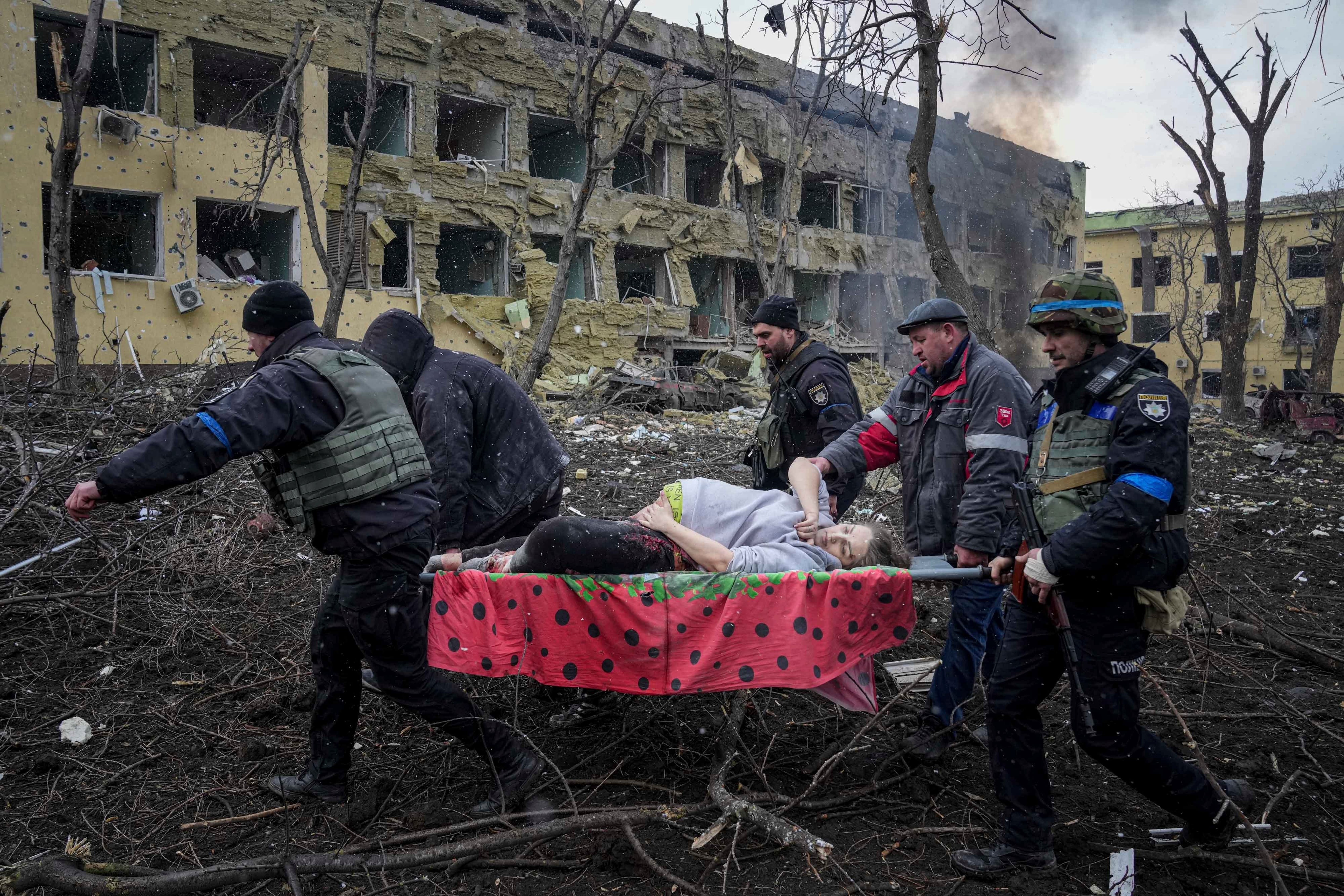The latest details about Russia’s attack on Ukraine:
A more brutal and indiscrimate war
5:22 p.m. EST March 9
A Russian airstrike devastated a maternity hospital Wednesday in the besieged port city of Mariupol amid growing warnings from the West that Moscow’s invasion is about to take a more brutal and indiscriminate turn. Ukrainian officials said at least 17 people were wounded in the attack.
The ground shook more than a mile away when the Mariupol complex was hit by a series of blasts that blew out windows and ripped away much of the front of one building. Police and soldiers rushed to scene to evacuate victims, carrying out a heavily pregnant and bleeding woman on a stretcher.
Another woman wailed as she clutched her child. In the courtyard, mangled cars burned, and a blast crater extended at least two stories deep.
“Today Russia committed a huge crime,” said Volodymir Nikulin, a top regional police official, standing in the ruins. “It is a war crime without any justification.”
President Volodymyr Zelenskyy wrote on Twitter that there were “people, children under the wreckage” and called the strike an “atrocity.” Video shared by Zelenskyy showed cheerfully painted hallways strewn with twisted metal.
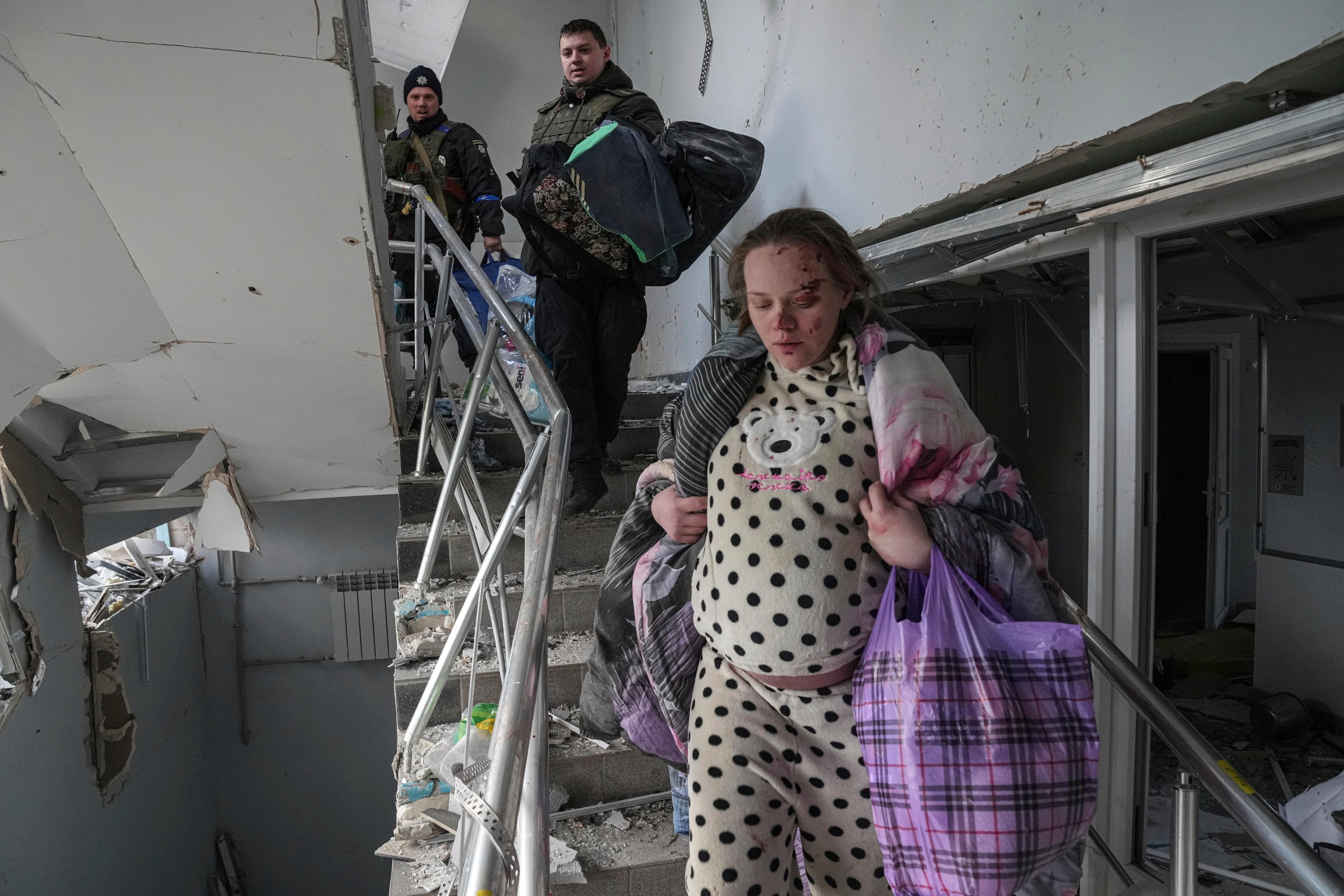
“There are few things more depraved than targeting the vulnerable and defenseless,” British Prime Minister Boris Johnson tweeted, adding that Russian President Vladimir Putin will be held “to account for his terrible crimes.”
Authorities, meanwhile, announced new cease-fires Wednesday morning to allow thousands of civilians to escape bombarded towns around Kyiv as well as the cities of Mariupol, Enerhodar and Volnovakha in the south, Izyum in the east and Sumy in the northeast.
It was not immediately clear whether anyone was able to leave other cities, but people streamed out of Kyiv’s suburbs, many headed for the city center, as explosions were heard in the capital and air raid sirens sounded repeatedly.
From there, the evacuees planned to board trains bound for western Ukrainian regions not under attack.
Civilians leaving the Kyiv suburb of Irpin were forced to make their way across the slippery wooden planks of a makeshift bridge, because the Ukrainians blew up the concrete span leading to Kyiv days ago to slow the Russian advance.
With sporadic gunfire echoing behind them, firefighters dragged an elderly man to safety in a wheelbarrow, a child gripped the hand of a helping soldier, and a woman inched her way along, cradling a fluffy cat inside her winter coat. They trudged past a crashed van with the words “Our Ukraine” written in the dust coating its windows.
“We have a short window of time at the moment,’’ said Yevhen Nyshchuk, a member of Ukraine’s territorial defense forces. “Even if there is a cease-fire right now, there is a high risk of shells falling at any moment.”
Previous attempts to establish safe evacuation corridors over the past few days largely failed because of what the Ukrainians said were Russian attacks. But Putin, in a telephone call with Germany’s chancellor, accused militant Ukrainian nationalists of hampering the evacuations.
In Mariupol, a strategic city of 430,000 people on the Sea of Azov, local authorities hurried to bury the dead from the past two weeks of fighting in a mass grave. City workers dug a trench some 25 meters (yards) long at one of the city’s old cemeteries and made the sign of the cross as they pushed bodies wrapped in carpets or bags over the edge.
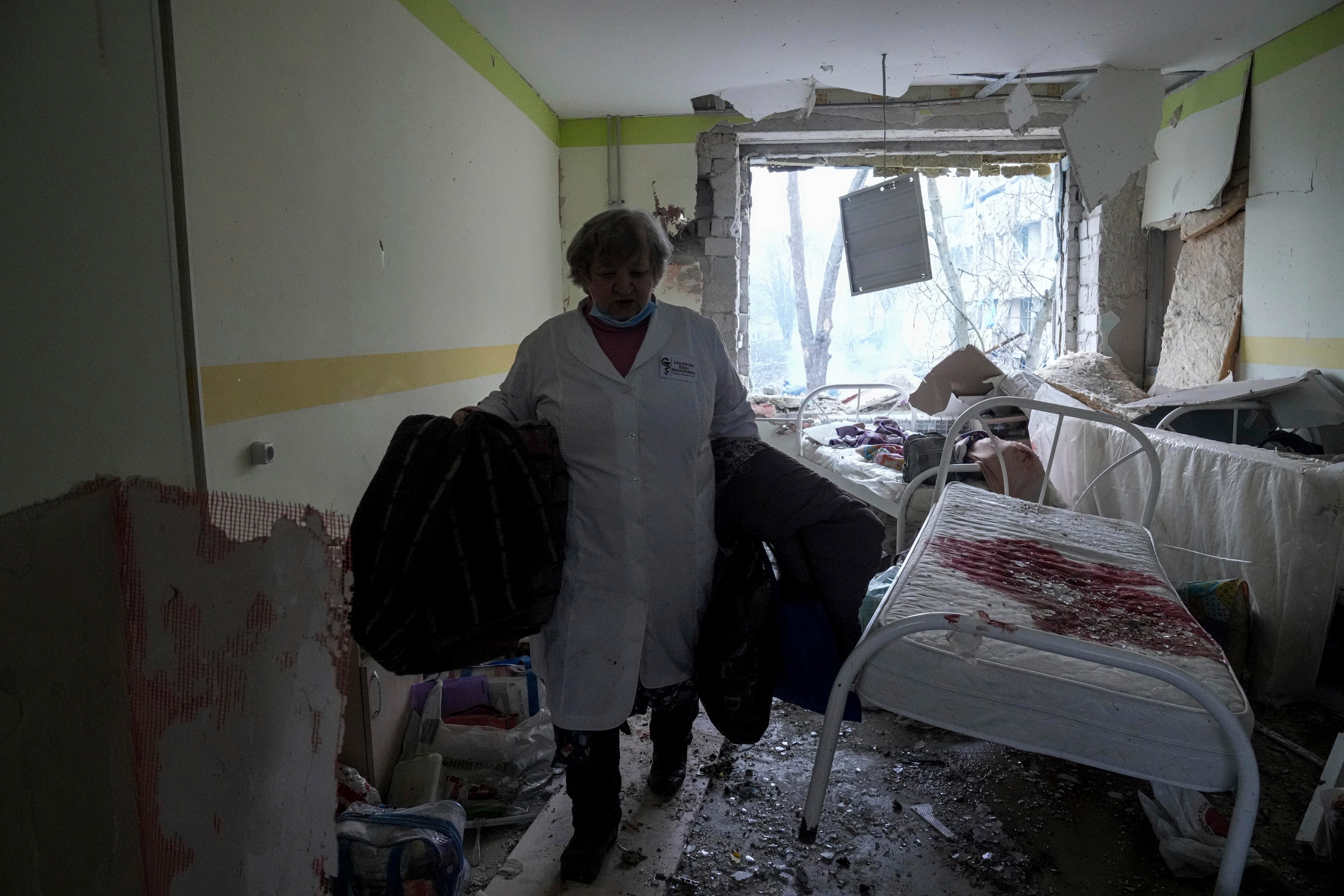
About 1,200 people have died in the nine-day siege of the city, Zelenskyy’s office said.
Nationwide, thousands are thought to have been killed, both civilians and soldiers, since Putin’s forces invaded. The U.N. estimates more than 2 million people have fled the country, the biggest exodus of refugees in Europe since the end of World War II.
The fighting knocked out power to the decommissioned Chernobyl nuclear plant, raising fears about the spent radioactive fuel that is stored at the site and must be kept cool. But the U.N. nuclear watchdog agency said it saw “no critical impact on safety” from the loss of power.
The crisis is likely to get worse as Moscow’s forces step up their bombardment of cities in response to what appear to be stronger Ukrainian resistance and heavier Russian losses than anticipated.
Echoing remarks from the director of the CIA a day earlier, British Defense Secretary Ben Wallace said Russia’s assault will get “more brutal and more indiscriminate” as Putin tries to regain momentum.
Britain’s Defense Ministry said fighting continued northwest of Kyiv. The cities of Kharkiv, Chernihiv, Sumy and Mariupol were being heavily shelled and remained encircled by Russian forces.
Russian forces are placing military equipment on farms and amid residential buildings in the northern city of Chernihiv, Ukraine’s military said. In the south, Russians in civilian clothes are advancing on the city of Mykolaiv, a Black Sea shipbuilding center of a half-million people, it said.
The Ukrainian military, meanwhile, is building up defenses in cities in the north, south and east, and forces around Kyiv are “holding the line” against the Russian offensive, authorities said.
On Wednesday, some of Ukraine’s volunteer fighters trained in a Kyiv park with rocket-propelled grenade launchers.
“I have only one son,” said Mykola Matulevskiy, a 64-year-old retired martial arts coach, who was with his son, Kostyantin. “Everything is my son.”
But now they will fight together: “It’s not possible to have it in another way because it’s our motherland. We must defend our motherland first of all.”
In Irpin, a town of 60,000, police officers and soldiers helped elderly residents from their homes. One man was hoisted out of a damaged structure on a makeshift stretcher, while another was pushed toward Kyiv in a shopping cart. Fleeing residents said they had been without power and water for the past four days.
Regional administration head Oleksiy Kuleba said the crisis for civilians is deepening in and around Kyiv, with the situation particularly dire in the suburbs.
“Russia is artificially creating a humanitarian crisis in the Kyiv region, frustrating the evacuation of people and continuing shelling and bombing small communities,” he said.
The situation is even worse in Mariupol, where efforts to evacuate residents and deliver badly needed food, water and medicine failed Tuesday because of what the Ukrainians said were continued Russian attacks.
The city took advantage of a lull in the shelling Wednesday to hurriedly bury 70 people. Some were soldiers, but most were civilians.
The work was conducted efficiently and without ceremony. No mourners were present, no families to say their goodbyes.
One woman stood at the gates of the cemetery to ask whether her mother was among those being buried. She was.
Associated Press journalists Yuras Karmanau in Lviv, Ukraine, and Felipe Dana and Andrew Drake in Kyiv contributed along with other reporters around the world.
Ukraine ‘using with greater effect’ weapons other than jets to fight Russia: Pentagon
1:50 p.m. EST March 9
The day after Poland offered up its entire MiG-29 fleet to help Ukraine fight Russia in the air, a senior U.S. defense official told reporters that Ukrainians “are using with greater effect other capabilities” to fight the Russians.
“We believe that that we are working very hard to get the Ukrainians the capabilities that they need and that they are using with great effect. And that’s where our focus is on,” the official said.
Following Poland’s announcement on Tuesday, Pentagon spokesman John Kirby said that the U.S. will work with Poland to consider their offer, “but we do not believe Poland’s proposal is a tenable one.”
The Pentagon has said repeatedly in recent days that Russia’s surface-to-air missile capabilities are a major threat to any fighter aircraft. The defense official said Wednesday that the thousands of missiles the U.S. has sent to Ukraine have been effective at keeping Russian airpower in check and have had a devastating effect on armor as well.
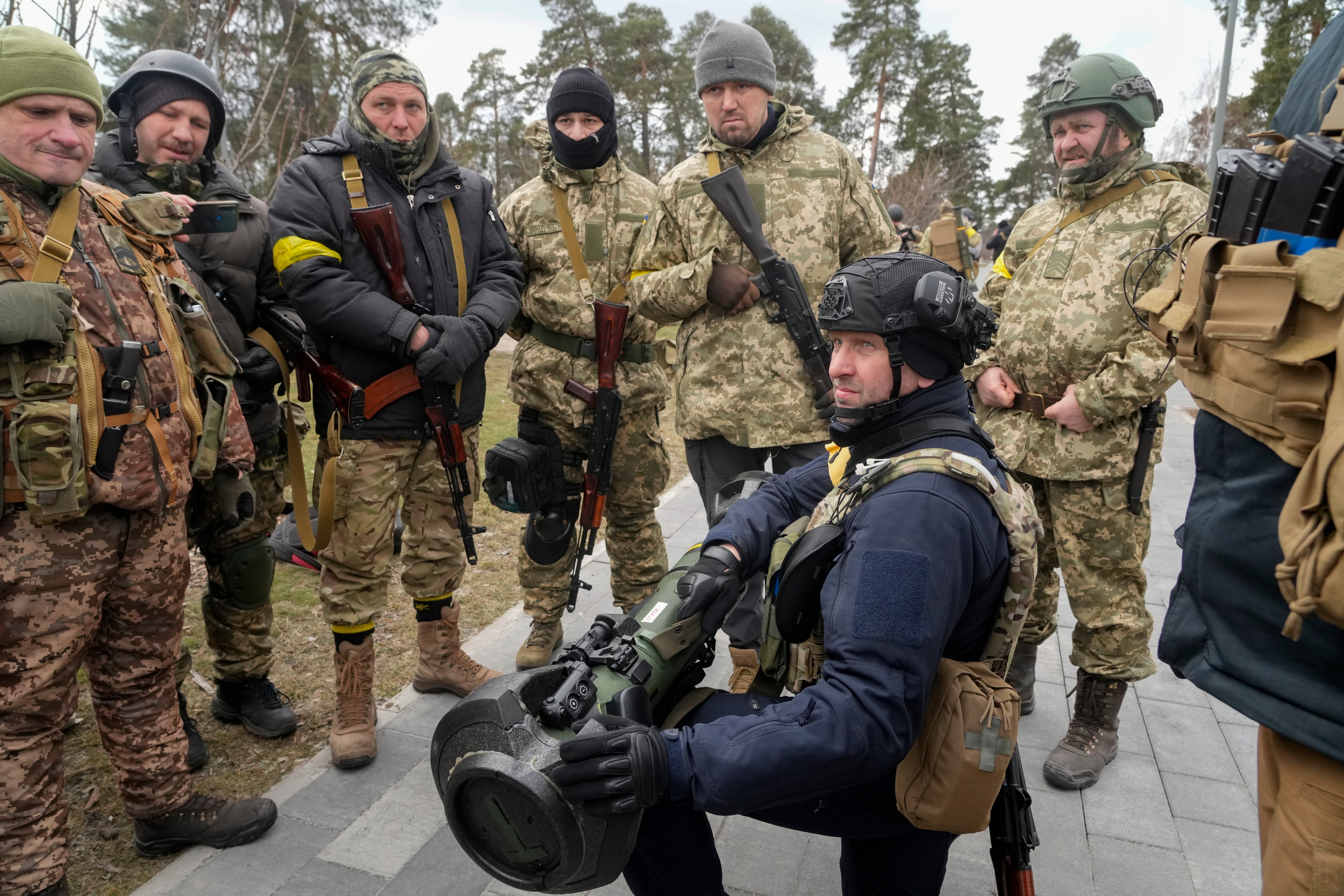
“So we believe our focus is on the right things the right kind of capabilities that they need to defend themselves are both in the air and on the ground,” he said.
Ukraine officials continue to ask for jets, anti-aircraft and anti-missile systems and a no-fly zone to protect against increasing Russian use of aviation and missile bombardment.
The Defense Department assesses that Russia still has use of about 90% of the combat power, in troops and equipment, that it brought into Ukraine. Several hundred vehicles have been taken out of service, the senior defense official said.
“We have no indication that the Russians are trying to gather any additional combat power or forces based additional to what they had assembled and amassed” prior to the invasion, the official said.
The Russians have made “no real ground progress” since Tuesday, the official said, except for getting about 20 kilometers closer to the city of Kharkiv.
“There’s still heavy, heavy fighting there,” the official said. “We don’t assess that they’ve taken the city by any means.”
The Russians are about 15 kilometers away from from the city of Mykolaiv in the south, the official said. There are no signs of amphibious attack on Odessa and Mariupol is “isolated,” the official said.
Ukraine officials say the Russians severaly damaged a maternity hospital there during attacks.
-Meghann Myers, Military Times
Mariupol maternity hospital severely damaged by Russian attack, officials say
12:10 p.m. EST March 9
A Russian attack severely damaged a maternity hospital in the besieged port city of Mariupol, Ukraine said Wednesday, and citizens trying to escape shelling on the outskirts of Kyiv streamed toward the capital amid warnings from the West that Moscow’s invasion is about to take a more brutal and indiscriminate turn.
President Volodymyr Zelenskyy wrote on Twitter that there were “people, children under the wreckage” of the hospital and called the strike an “atrocity.” Authorities said they were trying to establish how many people had been killed or wounded.
Video shared by Zelenskyy showed cheerfully painted hallways strewn with twisted metal and room after room with blown-out windows. Floors were covered in wreckage.
Outside, mangled cars burned, in a video provided by the Mariupol city council, with heavy damage to at least three two-story buildings. Much of the front of one building had been ripped away. The council said the damage was “colossal.”
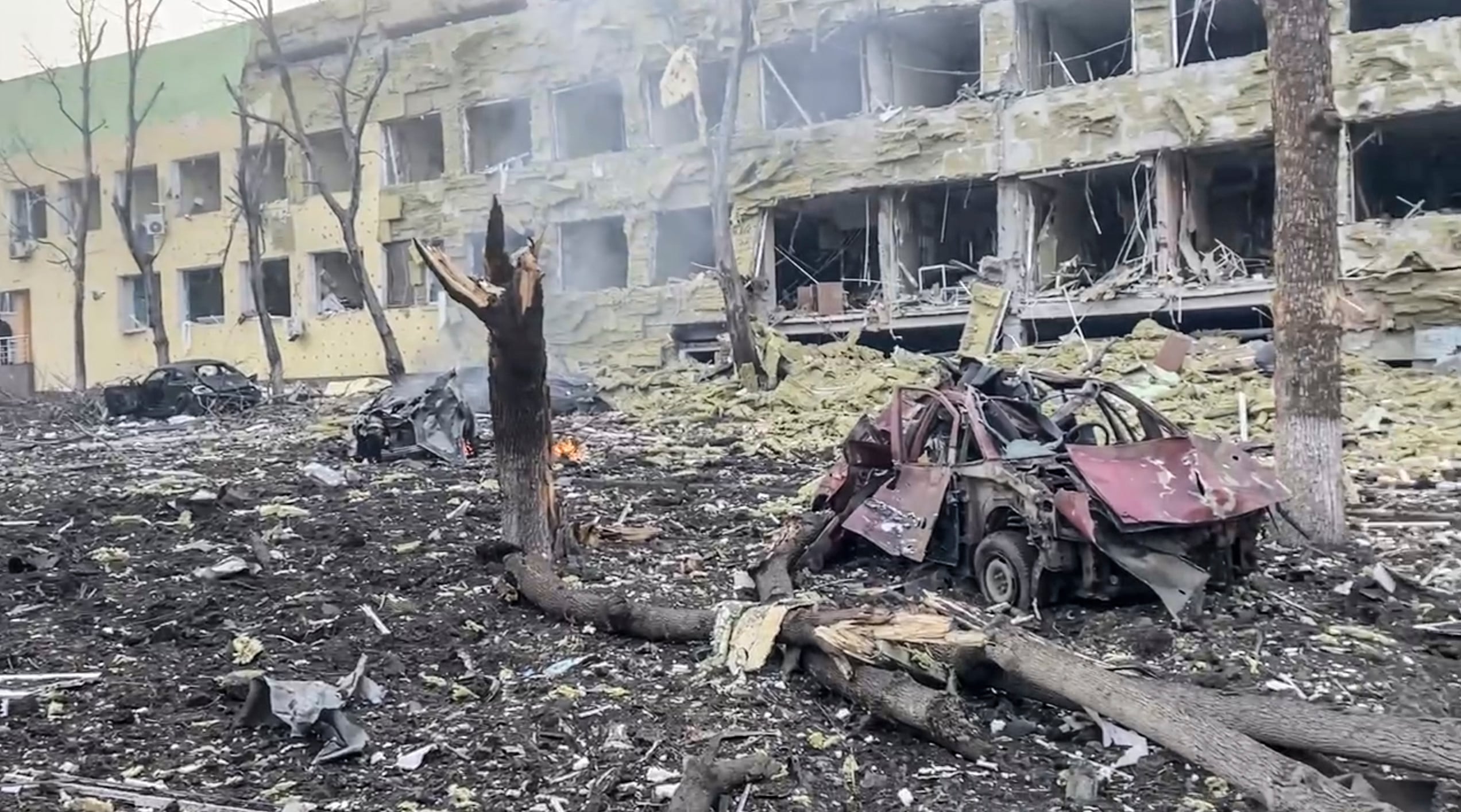
“There are few things more depraved than targeting the vulnerable and defenseless,” British Prime Minister Boris Johnson tweeted, adding that Russian President Vladimir Putin will be held “to account for his terrible crimes.”
Authorities, meanwhile, announced new cease-fires Wednesday morning to allow thousands of civilians to escape from towns around Kyiv as well as the southern cities of Mariupol, Enerhodar and Volnovakha, Izyum in the east and Sumy in the northeast.
Previous attempts to establish safe evacuation corridors largely failed because of what the Ukrainians said were Russian attacks. But Putin, in a telephone call with Germany’s chancellor, accused militant Ukrainian nationalists of hampering the evacuations.
It was not immediately clear whether anyone was able to leave other cities on Wednesday, but people streamed out of Kyiv’s suburbs, many headed for the city center, even as explosions were heard in the capital and air raid sirens sounded repeatedly. From there, the evacuees planned to board trains bound for western Ukrainian regions not under attack.
Civilians leaving the Kyiv suburb of Irpin were forced to make their way across the slippery wooden planks of a makeshift bridge, because the Ukrainians blew up the concrete span to Kyiv days ago to slow the Russian advance.
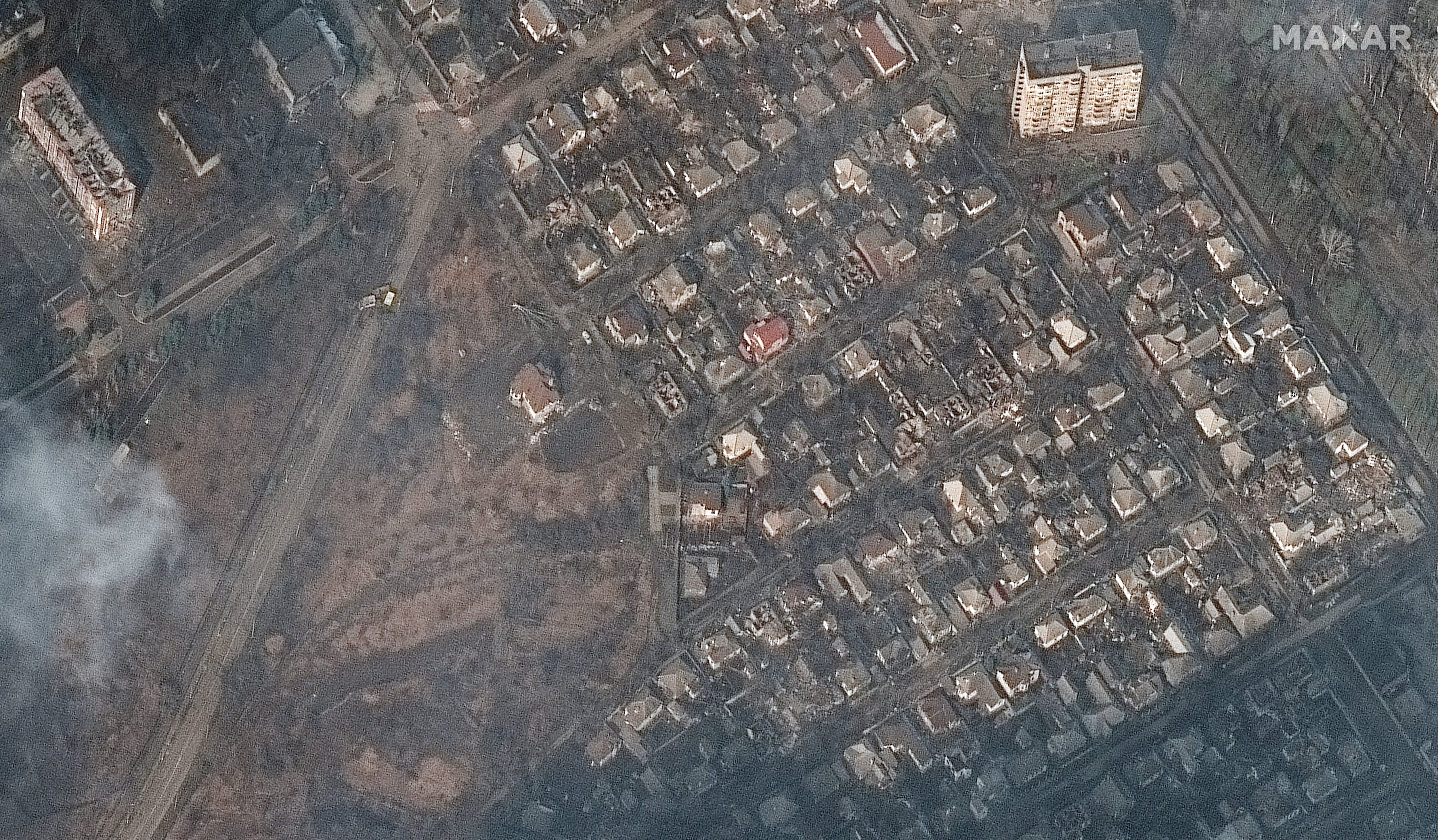
With sporadic gunfire echoing behind them, firefighters dragged an elderly man to safety in a wheelbarrow, a child gripped the hand of a helping soldier, and a woman inched her way along cradling a fluffy cat inside her winter coat. They trudged past a crashed van with the words “Our Ukraine” written in the dust coating its windows.
“We have a short window of time at the moment,’’ said Yevhen Nyshchuk, a member of Ukraine’s territorial defense forces. “Even if there is a cease-fire right now, there is a high risk of shells falling at any moment.”
In Mariupol, local authorities hurried to bury the dead in a mass grave. City workers dug a trench some 25 meters (yards) long at one of the city’s old cemeteries and made the sign of the cross as they pushed bodies wrapped in carpets or bags over the edge.
Nationwide, thousands are thought to have been killed, both civilians and soldiers, in the two weeks of fighting since Putin’s forces invaded. The U.N. estimates more than 2 million people have fled the country, the biggest exodus of refugees in Europe since the end of World War II.
The fighting knocked out power to the decommissioned Chernobyl nuclear plant, raising fears about the spent fuel that is stored at the site and must be kept cool. But the U.N. nuclear watchdog agency said it saw “no critical impact on safety” from the loss of power.
The crisis is likely to get worse as Moscow’s forces step up their bombardment of cities in response to what appear to be stronger Ukrainian resistance and heavier Russian losses than anticipated.
Echoing the director of the CIA, British Defense Secretary said Russia’s assault will get “more brutal and more indiscriminate” as Putin tries to regain momentum.
Britain’s Defense Ministry said fighting continued northwest of Kyiv. The cities of Kharkiv, Chernihiv, Sumy and Mariupol were being heavily shelled and remained encircled by Russian forces.
Russian forces are placing military equipment on farms and amid residential buildings in the northern city of Chernihiv, Ukraine’s military said. In the south, Russians in civilian clothes are advancing on the city of Mykolaiv, a Black Sea shipbuilding center of a half-million people, it said.
The Ukrainian military, meanwhile, is building up defenses in cities in the north, south and east, and forces around Kyiv are “holding the line” against the Russian offensive, authorities said.
In Irpin, a town of 60,000, police officers and soldiers helped elderly residents from their homes. One man was hoisted out of a damaged structure on a makeshift stretcher, while another was pushed toward Kyiv in a shopping cart. Fleeing residents said they had been without power and water for the past four days.
Regional administration head Oleksiy Kuleba said the crisis for civilians is deepening in and around Kyiv, with the situation particularly dire in the suburbs.
“Russia is artificially creating a humanitarian crisis in the Kyiv region, frustrating the evacuation of people and continuing shelling and bombing small communities,” he said.
The situation is even worse in Mariupol, a strategic city of 430,000 people on the Sea of Azov that has been encircled by Russian forces for the past week.
Efforts to evacuate residents and deliver badly needed food, water and medicine failed Tuesday because of what the Ukrainians said were continued Russian attacks.
The city took advantage of a lull in the shelling Wednesday to hurriedly bury 70 people. Some were soldiers, but most were civilians.
The work was conducted efficiently and without ceremony. No mourners were present, no families to say their goodbyes.
One woman stood at the gates of the cemetery to ask whether her mother was among those being buried. She was.
-Vadim Ghirda. Yuras Karmanau reported from Lviv, Ukraine. Associated Press journalists Felipe Dana and Andrew Drake in Kyiv, along with reporters from around the world, contributed to this report.
Ukraine president warns Russians against violating cease-fire
6:57 a.m. EST March 9
Ukrainian President Volodymyr Zelenskyy says efforts are under way to evacuate some 18,000 people from the capital Kyiv and embattled towns near it.
He said Wednesday the efforts are part of broader evacuation attempts by multiple humanitarian corridors within Ukraine, and warned Russian forces against violating cease-fire promises.
He appealed again for foreign air support, saying “send us planes.” Western powers have sent military equipment and beefed up forces on Ukraine’s eastern flank, but have been wary of providing air support and getting drawn into a direct war with Russia.
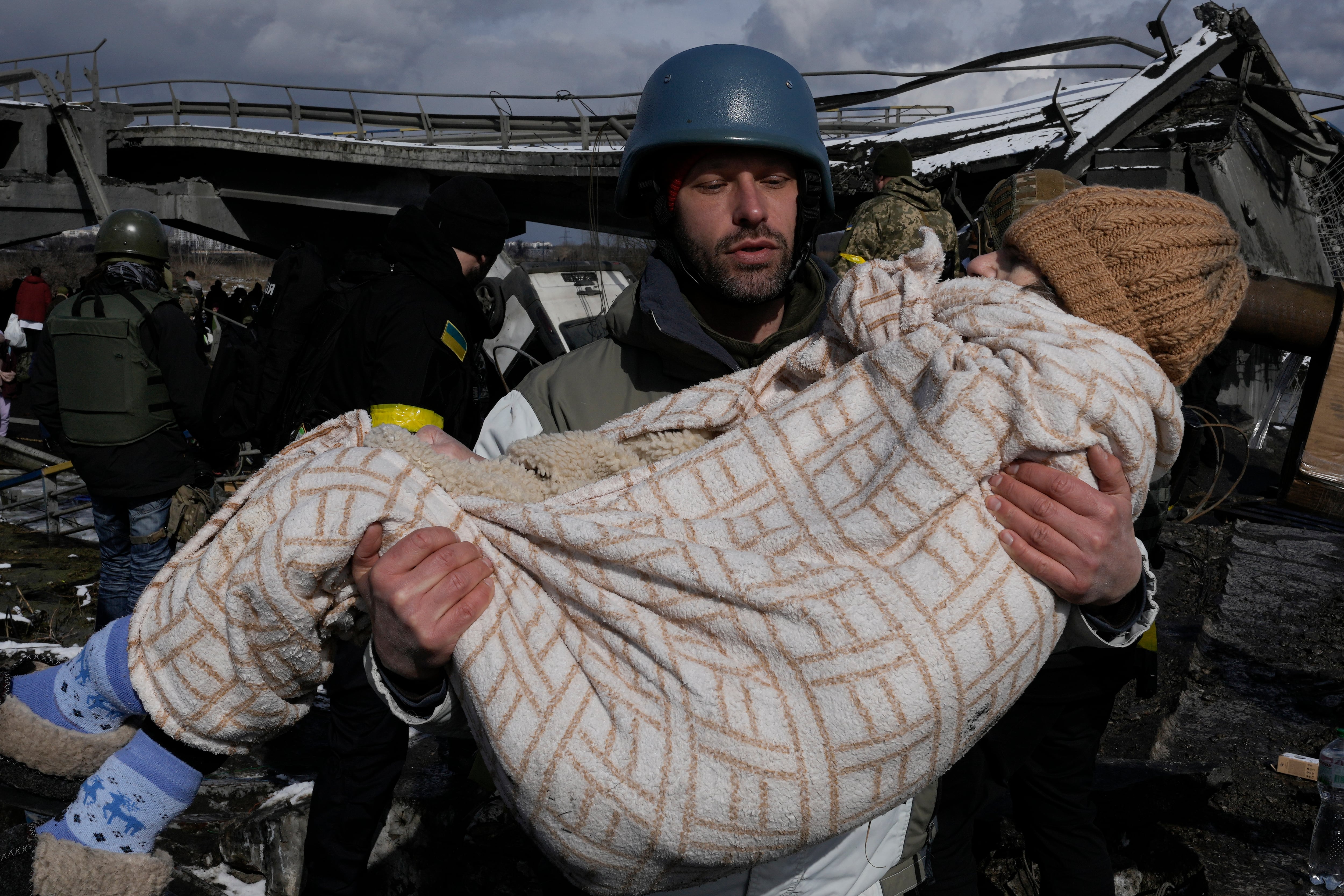
He also issued an appeal, unusually in Russian, to urge Russian soldiers to leave.
“Our resistance for almost two weeks has shown you that we will not surrender, because this is our home. It is our families and children. We will fight until we can win back our land,” he said. “You can still save yourselves if you just go home.”
Ukraine and Russia agree on new daylong cease-fire
6: 30 a.m. EST March 9
Air raid sirens blared over Ukraine’s capital on Wednesday and officials said they bolstered defenses in key cities threatened by Russian forces, as authorities renewed efforts to evacuate civilians from besieged urban areas.
Ukrainian officials announced Russia has agreed to a new daylong cease-fire along several evacuation routes for people fleeing cities, including Mariupol, scene of some of the worst desperation of the war. Russian shelling there has shattered buildings, leaving the port without water, heat, working sewage systems or phone service. Local officials said they planned to start digging mass graves for the dead.
Thousands of people are thought to have been killed, both civilians and soldiers, in two weeks of fighting since President Vladimir Putin’s forces invaded. The U.N. estimates that more than 2 million people have fled the country. Many more have become trapped inside cities bombarded and encircled by Russian forces, who have seen their advance slowed by fiercer than expected Ukrainian resistance.

Back-to-back alerts Wednesday morning urged residents of the capital, Kyiv, to go to bomb shelters quickly amid fears of incoming missiles. The all-clear was given each time, but the intermittent alerts have kept people on edge. Kyiv has been relatively quiet in recent days, though Russian artillery has pounded the outskirts of the city.
A new effort is planned Wednesday to create safe corridors for people to flee Mariupol, Sumy in the northeast, Enerhodar in the south, Volnovakha in the southeast, Izyum in the east, and several towns in the Kyiv region, Ukrainian Deputy Prime Minister Iryna Vereshchuk said.
The crisis is growing in the capital for civilians, with the situation particularly critical in the city’s suburbs, Kyiv regional administration head Oleksiy Kuleba.
“Russia is artificially creating a humanitarian crisis in the Kyiv region, frustrating the evacuation of people and continuing shelling and bombing small communities,” he said.
On the outskirts of the city, police officers and soldiers helped elderly residents from their homes Tuesday and people threaded their way along a destroyed bridge as they tried to escape Irpin, a town of 60,000 that has been targeted by Russian shelling.
RELATED
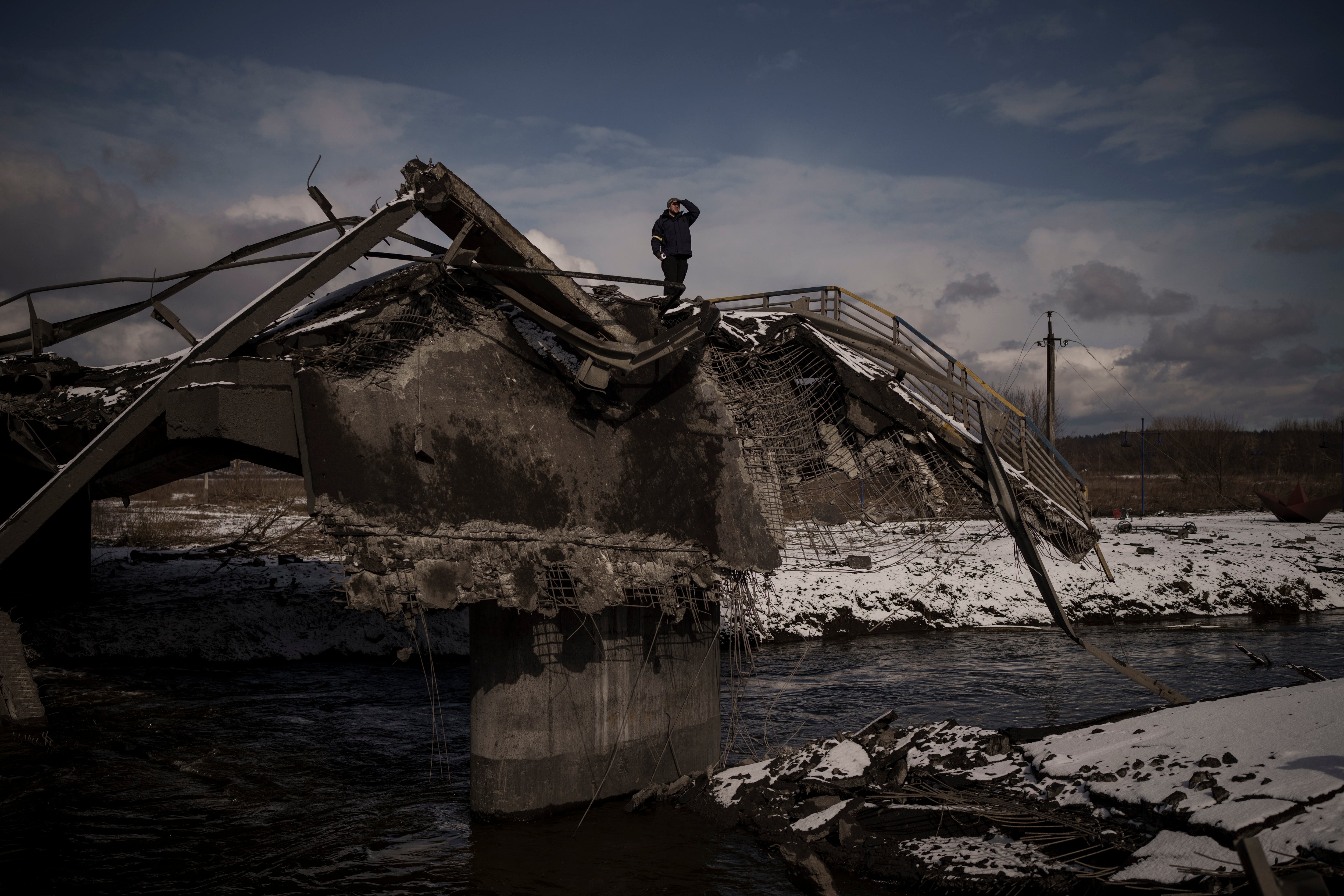
Meanwhile, Russian forces placed military equipment on farms and amid residential buildings in the northern city of Chernihiv, Ukraine’s general staff of the armed forces said in a statement. In the south, Russians dressed in civilian clothes are advancing on the city of Mykolaiv, a Black Sea shipbuilding center of a half-million people, it said.
The Ukrainian military is building up defenses in cities in the north, south and east, and forces around Kyiv are “holding the line” against the Russian offensive, the general staff said.
The fighting has largely thwarted earlier attempts to create corridors to safely evacuate civilians.
One evacuation did appear successful on Tuesday, with Ukrainian authorities saying 5,000 civilians, including 1,700 foreign students, managed to escape from Sumy, a city of a quarter-million people that has seen intense shelling.
That corridor will reopen for 12 hours on Wednesday, with the buses that took people southwest to the city of Poltava the day before returning to pick up more residents, regional administration chief Dmytro Zhyvytskyy said.
Priority was being given to pregnant women, women with children, older people and those with disabilities.
In the south, Russian troops have advanced deep along Ukraine’s coastline in an attempt to establish a land bridge to Crimea, which Moscow seized from Ukraine in 2014. As part of those efforts, the Azov Sea port of Mariupol has been surrounded by Russian soldiers for days and a humanitarian crisis is unfolding for the 430,000 residents.
Corpses lie in the streets, and hungry people break into stores in search of food and melt snow for water. Thousands huddle in basements, trembling at the sound of Russian shells pounding this strategic port city.
“Why shouldn’t I cry?” Goma Janna demanded as she wept by the light of an oil lamp below ground, surrounded by women and children. “I want my home, I want my job. I’m so sad about people and about the city, the children.”
Tuesday brought no relief: An attempt to evacuate civilians and deliver badly needed food, water and medicine through a designated safe corridor failed, with Ukrainian officials saying Russian forces had fired on the convoy before it reached the city.
Mariupol, said Ukrainian Deputy Prime Minister Iryna Vereshchuk, is in a “catastrophic situation.”
Natalia Mudrenko, a senior member of Ukraine’s U.N. Mission, told the Security Council that the people of Mariupol have “been effectively taken hostage” by the siege. Her voice shook with emotion as she described how a 6-year-old died shortly after her mother was killed by Russian shelling. “She was alone in the last moments of her life,” she said.
Theft has become widespread for food, clothes, even furniture, with locals referring to the practice as “getting a discount.” Some residents are reduced to scooping water from streams.
With the electricity out, many people are relying on their car radios for information, picking up news from stations broadcast from areas controlled by Russian forces or Russian-backed separatists.
Ludmila Amelkina, who was walking along an alley strewn with rubble and walls pocked by gunfire, said the destruction had been devastating.
“We don’t have electricity, we don’t have anything to eat, we don’t have medicine. We’ve got nothing,” she said, looking skyward.
Associated Press reporters from around the world contributed to this report.
Top lawmakers reach deal on Ukraine aid, $1.5T spending
6:20 a.m. EST March 9
Congressional leaders reached a bipartisan deal early Wednesday providing $13.6 billion to help Ukraine and European allies plus billions more to battle the pandemic as part of an overdue $1.5 trillion measure financing federal agencies for the rest of this year.
Though a tiny fraction of the massive bill, the money countering a Russian blitzkrieg that’s devastated parts of Ukraine and prompted Europe’s worst refugee crisis since World War II ensured the measure would pass with robust bipartisan support. President Joe Biden requested $10 billion for military, humanitarian and economic aid last week, and Democratic and Republican backing was so staunch that the figure grew to $12 billion Monday and $13.6 billion just a day later.
“We’re going to support them against tyranny, oppression, violent acts of subjugation,” Biden said at the White House.
Party leaders planned to whip the 2,741-page measure through the House on Wednesday and the Senate by week’s end, though that chamber’s exact timing was unclear. Lawmakers were spurred by the urgency of helping Ukraine before Russia’s military might makes it too late.
They also faced a Friday deadline to approve the government-wide spending measure or face a weekend election-year federal shutdown. As a backstop against delays, the House planned to pass a bill Wednesday keeping agencies afloat through March 15.
Over $4 billion of the Ukraine aid was to help the country and Eastern European nations cope with the 2 million refugees who’ve already fled the fighting. Another $6.7 billion was for the deployment of U.S. troops and equipment to the region and to transfer American military items to Ukraine and U.S. allies, and there was economic aid and money to enforce economic sanctions against Russia as well.
“War in Europe has focused the energies of Congress to getting something done and getting it done fast,” said Senate Majority Leader Chuck Schumer, D-N.Y.
Senate Minority Leader Mitch McConnell, R-Ky., said the measure would provide loan guarantees to Poland to help it replace aircraft it is sending Ukraine. “It’s been like pulling teeth” to get Democrats to agree to some of the defense spending, he said. But he added, “It’s an important step. It needs to be passed. It needs to be passed quickly.”
The bipartisan rallying behind the Ukraine aid was just one manifestation of Congress’ eagerness to help the beleaguered country, though not all of it has been harmonious.
Republicans accused Biden of moving too slowly to help Ukraine and NATO allies and to impose sanctions against Russia and its president, Vladimir Putin. Democrats countered that time was needed to bring along European allies that rely heavily on Russian energy sources. And a bipartisan push to ban Russian oil imports had become nearly unstoppable before Biden announced Tuesday that he would do that on his own.
The huge overall bill was stocked with victories for both parties.
For Democrats, it provides $730 billion for domestic programs, 6.7% more than last year, the biggest boost in four years. Republicans won $782 billion for defense, 5.6% over last year’s levels.
In contrast, Biden’s 2022 budget last spring proposed a 16% increase for domestic programs and less than 2% more for defense — numbers that were doomed from the start thanks to Democrats’ slender congressional majorities.
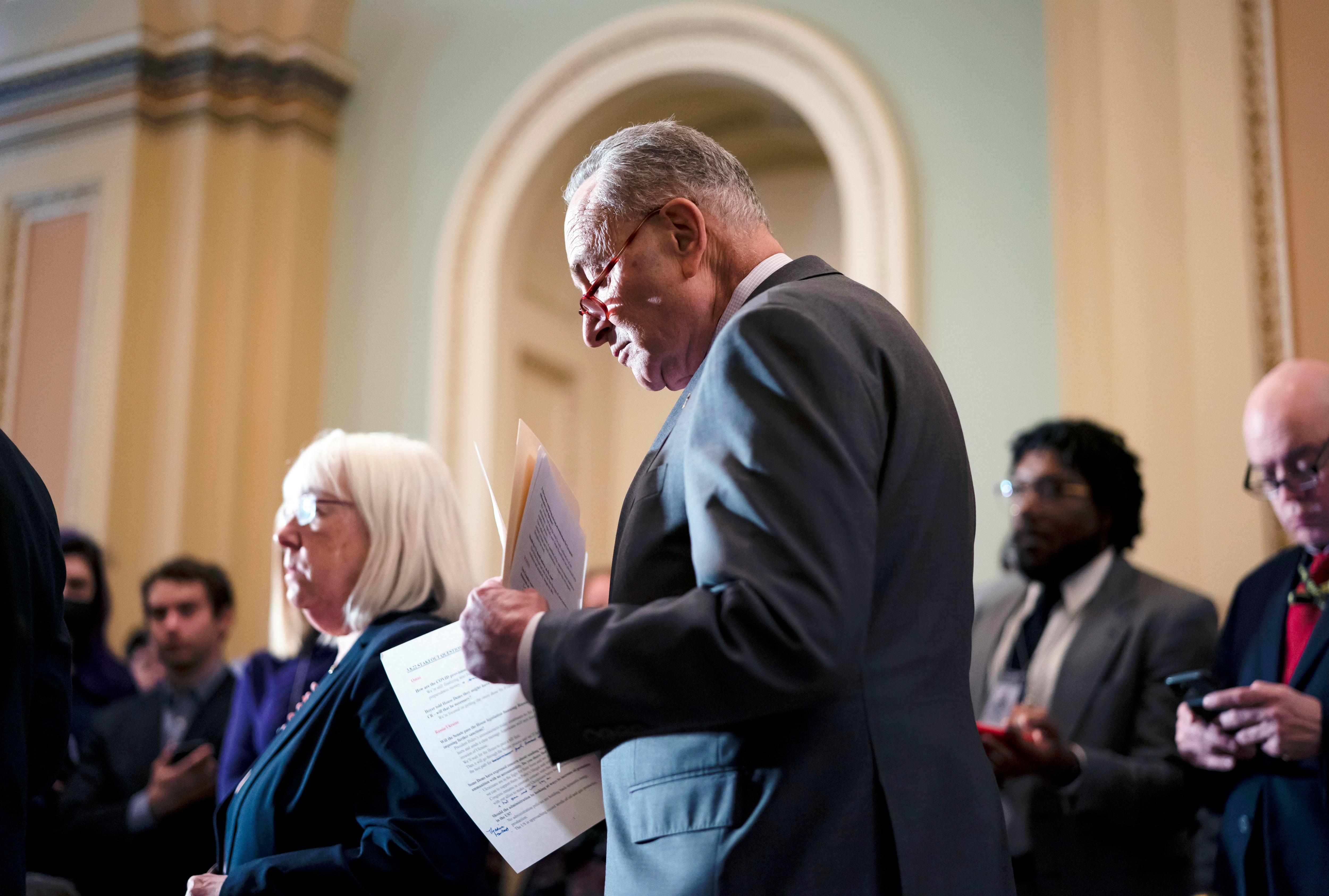
The bill was also fueled by large numbers of hometown projects for both parties’ lawmakers, which Congress had banned since 2011 but were revived this year. The spending — once called earmarks, now dubbed community projects — includes money for courthouses in Connecticut and Tennessee and repairs to a post office in West Virginia. And it names a federal building in Tuscaloosa, Alabama, after Sen. Richard Shelby, the state’s senior GOP senator, a chief author of the bill who’s retiring after six terms.
Democrats won $15.6 billion for a fresh round of spending for vaccines, testing and treatments for COVID-19, including $5 billion for fighting the pandemic around the world. That was below Biden’s $22.5 billion request.
Republicans said they’d forced Democrats to pay for the entire amount by pulling back money from COVID-19 relief bills enacted previously. Much of the money was to go to help states and businesses cope with the toll of the pandemic.
There’s added money for child care, job training, economic development in poorer communities and more generous Pell grants for low-income undergraduates. Public health and biomedical research would get increases, including $194 million for Biden’s “Cancer Moonshot” effort to cure the disease.
Citizenship and Immigration Services would get funds to reduce huge backlogs of people trying to enter the U.S. There would be fresh efforts to bolster renewable energy and curb pollution, with some of that aimed specifically at communities of color.
There is added funding to build affordable housing. And the measure distributes billions of dollars initially provided by the bipartisan infrastructure bill enacted last year for road, rail and airport projects.
The bill “delivers transformative federal investments to help lower the cost of living for working families, create American jobs, and provide a lifeline for the vulnerable,” said House Appropriations Committee Chair Rosa DeLauro, D-Conn.
The bill renews programs protecting women against domestic violence and requires many infrastructure operators to report significant cyber attacks and ransomware demands to federal authorities. The Defense Department would have to report on extremist ideologies within the ranks.
The measure retains strict decades-old curbs against using federal money for nearly all abortions. It has $300 million in military assistance for Ukraine and $300 million to help nearby countries like the Baltic nations and Poland. Service members would get 2.7% pay raises, and Navy shipbuilding would get a boost in a counter to China.
It “rejects liberal policies and effectively addresses Republican priorities,” said Shelby, top Republican on the Senate Appropriations Committee.
Since the government’s fiscal year began last Oct. 1, agencies have been running on spending levels approved during Donald Trump’s final weeks in the White House. Congress has approved three short-term bills since then keeping agency doors open.
